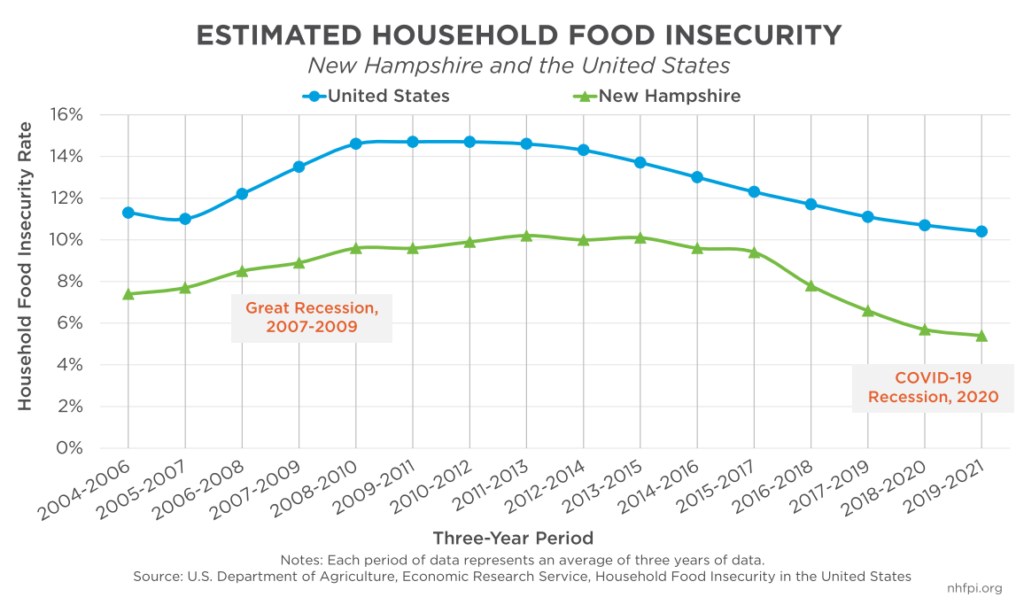New data show that food insecurity among New Hampshire households declined in the last three years, with federal assistance programs helping to offset the negative effects of economic upheavals caused by the COVID-19 pandemic.
The U.S. Department of Agriculture (USDA) surveys households each year to understand the prevalence of food insecurity across the nation. The USDA defines food insecurity as when households are, at least at some times in a year, unable to acquire adequate food for one or more adults or children in a household because of insufficient money or other resources. At the state level, these USDA data are aggregated into three-year periods to have sufficient data for more reliable estimates. The newest data, covering the years 2019-2021, were released in September 2022.
In the 2019-2021 period, food insecurity in New Hampshire impacted an estimated 30,000 households, or 5.4 percent of all Granite State households. This percentage is a significant decline from both the 7.8 percent estimated for the previous three-year period, covering 2016-2018, and from the approximately one in ten food-insecure households following the rise in food insecurity during the Great Recession and in the early years of the subsequent long, slow recovery.
This decline occurred despite unemployment in New Hampshire spiking during the worst periods of the COVID-19 crisis, and nearly half of New Hampshire households losing employment income between March and July 2020. As with poverty, widespread food insecurity was likely prevented because of expanded federal aid programs during the pandemic, as well as State assistance and charitable giving.
Several key program expansions were targeted at reducing food insecurity in pandemic-related legislation, including for the Supplemental Nutrition Assistance Program (SNAP), the Special Supplemental Nutrition Program for Women, Infants, and Children (WIC), and programs for free and reduced-price meals for children at school. Additionally, the Pandemic EBT program was created to provide meals to students who would otherwise be receiving free or reduced-price meals at school, but were unable to attend school due to the pandemic. These targeted food assistance programs, which reached one third of households with children in New Hampshire, were complemented by expanded income support programs, such as enhanced unemployment compensation, increased tax credits for child care expenses, several rounds of Economic Impact Payments, and the expanded Child Tax Credit, which delivered $320.7 million in advance, monthly payments during the second half of 2021 to eligible New Hampshire households with children.
While New Hampshire retained a low food insecurity rate relative to the nation, these declines were not unique to the Granite State, indicating the robust impacts of federal policies. Nationwide, food insecurity fell by 1.3 percent between the 2016-2018 period and the 2019-2021 period. While New Hampshire had the lowest estimated food insecurity rate of any state in the nation, it did not have the lowest estimated rate among states for households with very low food insecurity, a more severe form of food insecurity.
More detailed national data also provide additional insights into differing impacts on food insecurity. In 2021, households with children, with people living alone or as single parents with children, with householders who identify as Black or Hispanic, or with incomes below 185 percent of the federal poverty threshold were all more likely to be food insecure than households overall. However, between 2020 and 2021, food insecurity declined nationwide for households with children, for married couple and single-female-headed households with children, for households with poverty-level incomes and those below 185 percent of the poverty threshold, and for households with householders who identified as both Black and non-Hispanic. Nationally, food insecurity increased for households without children, for women living alone, and for older adults living alone. These shifts in food insecurity between 2020 and 2021 suggest targeted assistance programs, such as the expanded Child Tax Credit, were effective at alleviating food insecurity among the households they reached, but the ongoing economic impacts from the pandemic may have still increased food insecurity among other households.
These newly-released USDA food insecurity data and separate U.S. Census Bureau data on poverty and income, also released in September 2022, provide clear indications that the targeted assistance programs for households with lower incomes helped alleviate hardships for individuals and families at a very difficult time. Rapid action on the part of governments to respond to the COVID-19 crisis reduced the negative impacts of the pandemic in a much more robust and inclusive manner than the response to the Great Recession, and helped to promote a more equitable recovery.
– Phil Sletten, Research Director

